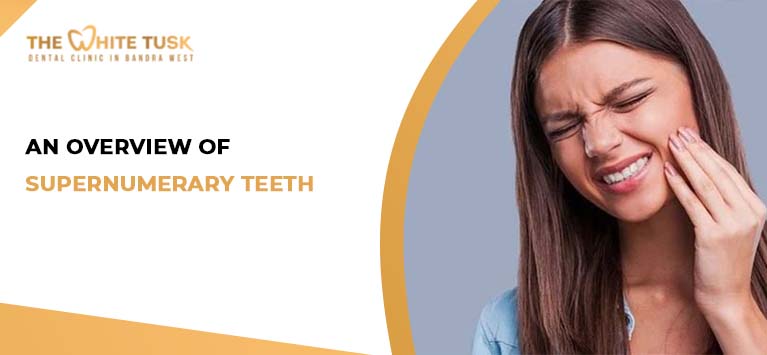
Supernumerary teeth, also known as extra teeth.These additional teeth can appear in various locations in the mouth, and their presence can pose challenges in terms of oral health and aesthetics.
In this blog post, we will provide you with an in-depth overview of supernumerary teeth, including their causes, types, and potential impacts on oral health. So, keep reading to expand your knowledge on supernumerary teeth.
In normal adult dentition, 32 teeth are composed of 8 incisors, 4 canines, 8 premolars, and 12 molars (including 4 wisdom teeth) and an extra tooth that is not in line with the typical dental formula is supernumerary teeth. These extra teeth may appear anywhere in the oral cavity and can be of different sizes, shapes, or locations.
Apart from the regular teeth, they may also appear in places that are not usually filled with teeth. Supernumerary teeth are more common in the front of the mouth (anterior region) than in the back (posterior region), and they are often classified based on their location and shape.
Hyperdontia is a dental condition that occurs because of supernumerary teeth. This condition will affect your normal teeth growth, trying to push the teeth out of their position and attempting to damage root tissues in other teeth. Hyperdontia is most likely to be detected during childhood and adolescence. In this stage, the eruption of the main teeth and root teeth increases the likelihood that additional teeth can be identified.
They’re extra teeth that look like regular teeth usually found at the end of a series of teeth.
These are small, cone-shaped extra teeth that will grow behind your front teeth
These are more complex extra teeth with multiple points and bumps, like mini molars or premolars
These are extra teeth that form in dental growths called odontomas, resulting in the formation of clusters of crooked teeth.
Yes, genetic factors and genetic abnormalities can sometimes cause supernumerary teeth. Although it is not entirely clear what causes the supernumerary teeth, there are indications that genetic mutations and variations may be involved in their development. Conditions like cleidocranial dysplasia and Gardner syndrome, which have a genetic basis, are examples of disorders where supernumerary teeth can be a characteristic feature. However, it is important to note that not all cases of supernumerary teeth are directly related to genetic disorders, as environmental factors may also contribute to their occurrence.
The removal of the additional teeth is the primary therapy for hyperdontia. In the case where the supernumerary teeth are partially or fully erupted, local or general anesthesia will be given to extract a supernumerary tooth, a dental instrument known as an elevator is used to wiggle the tooth, once it is done the tooth is carefully taken out with dental forceps. If the supernumerary tooth is impacted, oral surgery will be conducted to remove the tooth. In this method, an incision is made into the gum, then the impacted tooth will be broken into pieces and removed.
Hyperdontia will lead to certain complications to the teeth and their formations such as
We hope you found our overview of supernumerary teeth informative and insightful. In this blog we covered the causes and treatment options for supernumerary teeth and its associated condition. If you have any further questions or would like to learn more, please don’t hesitate to reach out to us.